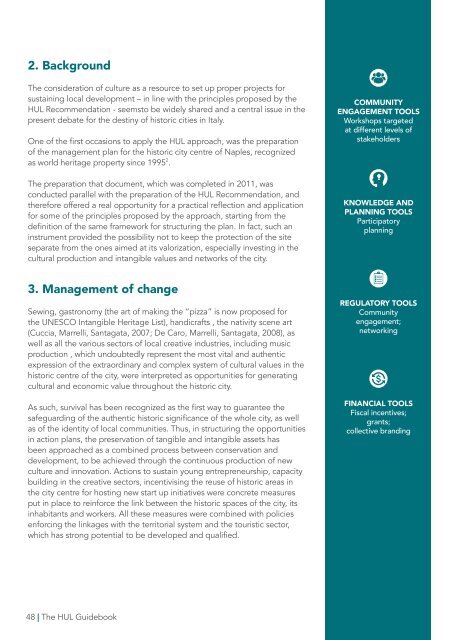GUIDEBOOK
wirey5prpznidqx
wirey5prpznidqx
You also want an ePaper? Increase the reach of your titles
YUMPU automatically turns print PDFs into web optimized ePapers that Google loves.
2. Background<br />
The consideration of culture as a resource to set up proper projects for<br />
sustaining local development – in line with the principles proposed by the<br />
HUL Recommendation - seemsto be widely shared and a central issue in the<br />
present debate for the destiny of historic cities in Italy.<br />
One of the first occasions to apply the HUL approach, was the preparation<br />
of the management plan for the historic city centre of Naples, recognized<br />
as world heritage property since 1995 2 .<br />
The preparation that document, which was completed in 2011, was<br />
conducted parallel with the preparation of the HUL Recommendation, and<br />
therefore offered a real opportunity for a practical reflection and application<br />
for some of the principles proposed by the approach, starting from the<br />
definition of the same framework for structuring the plan. In fact, such an<br />
instrument provided the possibility not to keep the protection of the site<br />
separate from the ones aimed at its valorization, especially investing in the<br />
cultural production and intangible values and networks of the city.<br />
COMMUNITY<br />
ENGAGEMENT TOOLS<br />
Workshops targeted<br />
at different levels of<br />
stakeholders<br />
KNOWLEDGE AND<br />
PLANNING TOOLS<br />
Participatory<br />
planning<br />
3. Management of change<br />
Sewing, gastronomy (the art of making the “pizza” is now proposed for<br />
the UNESCO Intangible Heritage List), handicrafts , the nativity scene art<br />
(Cuccia, Marrelli, Santagata, 2007; De Caro, Marrelli, Santagata, 2008), as<br />
well as all the various sectors of local creative industries, including music<br />
production , which undoubtedly represent the most vital and authentic<br />
expression of the extraordinary and complex system of cultural values in the<br />
historic centre of the city, were interpreted as opportunities for generating<br />
cultural and economic value throughout the historic city.<br />
As such, survival has been recognized as the first way to guarantee the<br />
safeguarding of the authentic historic significance of the whole city, as well<br />
as of the identity of local communities. Thus, in structuring the opportunities<br />
in action plans, the preservation of tangible and intangible assets has<br />
been approached as a combined process between conservation and<br />
development, to be achieved through the continuous production of new<br />
culture and innovation. Actions to sustain young entrepreneurship, capacity<br />
building in the creative sectors, incentivising the reuse of historic areas in<br />
the city centre for hosting new start up initiatives were concrete measures<br />
put in place to reinforce the link between the historic spaces of the city, its<br />
inhabitants and workers. All these measures were combined with policies<br />
enforcing the linkages with the territorial system and the touristic sector,<br />
which has strong potential to be developed and qualified.<br />
REGULATORY TOOLS<br />
Community<br />
engagement;<br />
networking<br />
FINANCIAL TOOLS<br />
Fiscal incentives;<br />
grants;<br />
collective branding<br />
48 | The HUL Guidebook


